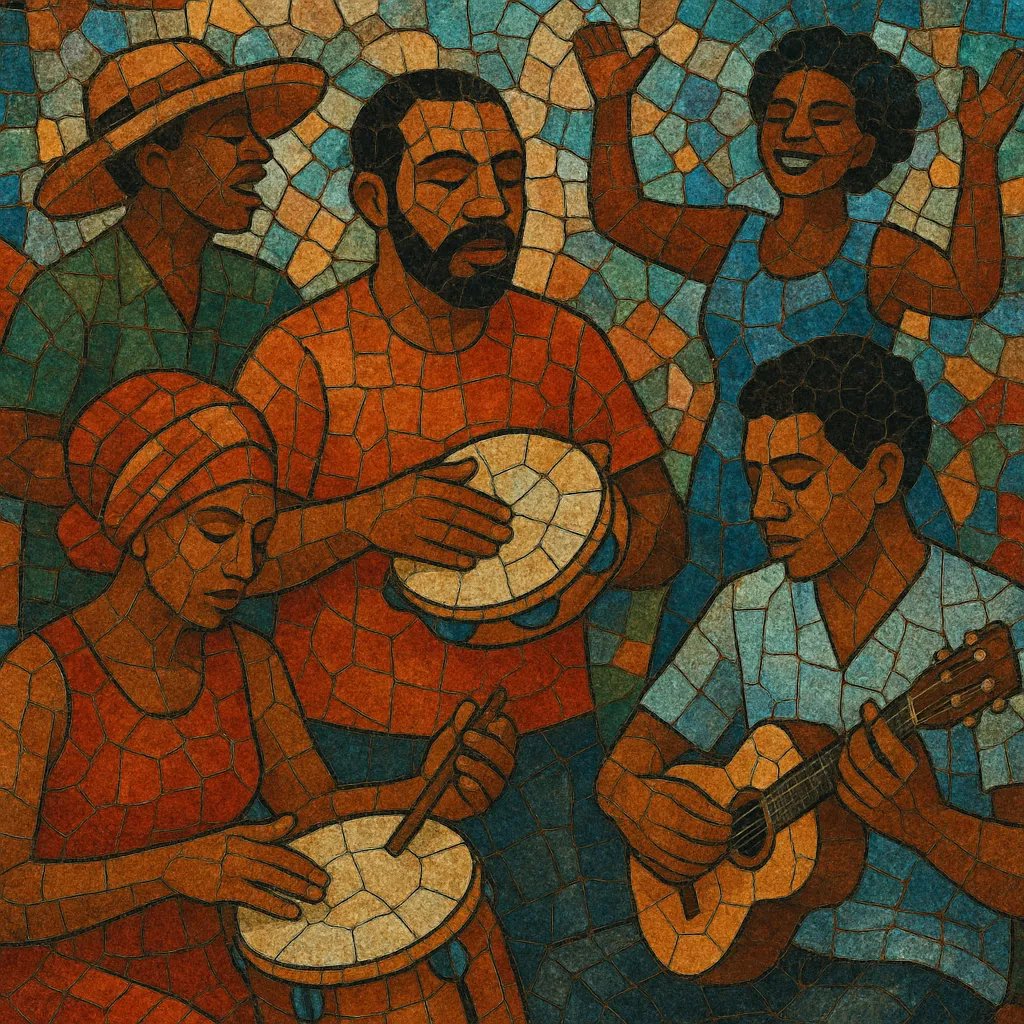Samba de terreiro is a branch of Rio de Janeiro samba cultivated in the terreiros and quadras of samba schools, outside the carnival parade proper. It is the communal samba performed at rehearsals, celebrations, and gatherings, where the school’s bateria, singers, and neighborhood chorus animate call-and-response refrains.
Musically it favors a swung 2/4 feel with dense, interlocking percussion (surdos, caixa, repinique, tamborim, pandeiro, cuíca, chocalhos/ganza, agogô), and a harmonic base led by cavaquinho and 6/7‑string guitar. Lyrically it often praises the school, its neighborhood, history, and symbols, and can carry spiritual echoes from Afro‑Brazilian religious culture.
Compared with samba‑enredo (composed to narrate the yearly parade theme), samba de terreiro is less tied to a narrative brief and more to the school’s identity and community swing, encouraging collective singing and dancing.
Samba de terreiro grows from the post‑abolition Afro‑Brazilian samba culture in Rio de Janeiro’s "Pequena África" and backyard/yard (terreiro) gatherings linked to casas de santo and community festivities. As samba schools formed around the late 1920s and early 1930s (e.g., Mangueira, Portela), a repertoire of sambas intended for rehearsals and celebrations in the school’s quadra emerged—what came to be called samba de terreiro.
Record labels and radio occasionally labeled these pieces as "samba de terreiro," distinguishing them from other samba formats. Composers and interpreters tied to schools (Cartola, Paulo da Portela, Monarco, Manacéa, Silas de Oliveira, Dona Ivone Lara, Nelson Sargento, among others) shaped the idiom: medium to upbeat grooves, strong community choruses, and lyrics exalting the school and its symbols.
As carnival parades professionalized, samba‑enredo became the competition centerpiece. Samba de terreiro, however, remained vital within quadras—fueling parties, rehearsals, and school identity beyond the parade season. Velha Guarda groups and community rodas preserved traditional forms, performance practice, and repertoire.
While newer samba currents (e.g., pagode) gained commercial traction, many of their artists and arranging practices descend from samba‑school culture. Today, samba de terreiro lives in rehearsal nights, community recordings, and heritage projects tied to schools, maintaining its role as a communal, identity‑affirming samba and a living bridge to the genre’s Afro‑Brazilian roots.
Use a samba‑school‑style percussion battery: surdos (1st marking the downbeat, 2nd/3rd answering offbeats), caixa (carreteiro pattern), repinique/repique (calls and breaks), tamborim (telecoteco syncopations), pandeiro, cuíca (melodic growls), agogô, and chocalhos/ganza. Harmonically, center the groove with cavaquinho (syncopated comping) and 6/7‑string guitar (bass counterlines and cadential runs).
Write in 2/4 with a pronounced swing. Aim for a medium‑to‑upbeat dance tempo and a tightly interlocked polyrhythmic battery. Emphasize call‑and‑response between a lead singer (puxador) and the community chorus, and punctuate sections with short breaks (paradinhas) to feature the coro or harmonic instruments.
Favor bright major keys and functional harmony: I–IV–V with secondary dominants and II–V–I movements are idiomatic. Melodies should be singable, with memorable refrains designed for crowd participation. Cadences often land strongly on the tonic with pickup phrases that propel back into the groove.
Focus on exalting the school, its neighborhood, colors, symbols, and heroes; celebrate communal values and Afro‑Brazilian heritage. Keep verses concise and refrain‑driven to facilitate call‑and‑response. Poetic images, historical references, and praise language (exaltação) are common.
Typical forms alternate verses and refrains, with coro sections repeating to build energy. Layer percussion patterns gradually, introduce sectional breaks, and spotlight the chorus. In performance, keep dynamics responsive to dancers and singers—samba de terreiro thrives on crowd interaction and groove stability.


